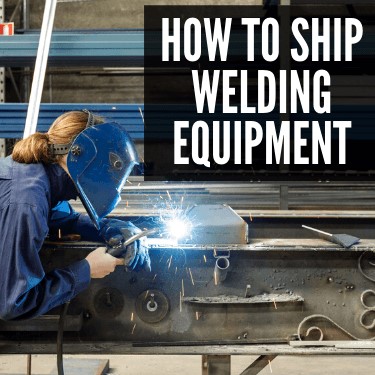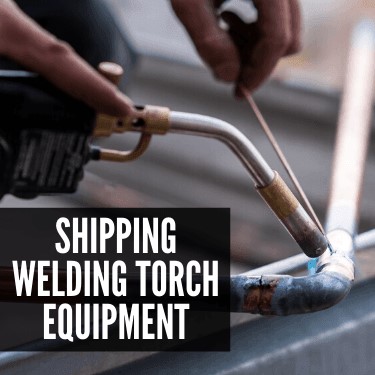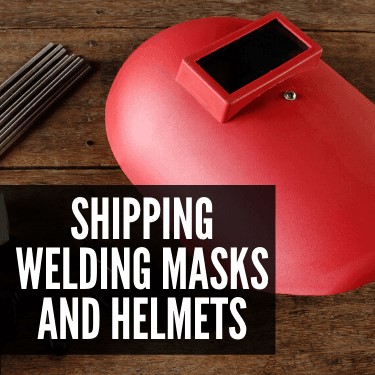Welding requires a lot of different tools, and each of those tools has different requirements for shipping. If shipping welding equipment is on your agenda, then you’re going to need a plan to orchestrate the shipment of multiple different types of freight. A third-party logistics (3PL) company like R+L Global Logistics can take a lot of the stress off your shoulders by finding you the right carrier to move your freight. We only work with the best, most reliable carriers in the business, so you can rest easy and hand the hard work off to us.
Shipping welding equipment sometimes requires special handling. Large welding machines and power tools must be palletized to make them easy to ship, while some equipment, like PPE, requires less work to ship. Your approach to shipping different items should be tailored to that item’s durability, size, weight, and special handling requirements.

When you’re shipping welding equipment, it helps to take a tailored approach to how you handle each different kind of item. You obviously cannot ship gas cylinders the same way you would ship power tools, or you would have a problem on your hands.
The best way to ship anything is with a 3PL. A dedicated freight agent will work with you to find the best deal for your shipments, and connect you with a qualified carrier. If you have equipment that requires special handling, then you won’t have to waste time searching for someone with the right qualifications to transport it. The 3PL agent will find a carrier that meets your needs and handle all communication with them for you.
However, even though there is a lot that your 3PL partner can help you with, it is still your responsibility to ensure your products are packaged correctly so they have a safe trip.
Plasma cutters are heavy, but they are relatively compact. For shipping, you have to make sure the boxes they are packed in will be strong enough to support not only the weight of the plasma cutter inside it, but also the weight of dozens of others stacked on top of it. That’s because the easiest way to ship them is by palletizing them, but you might want to consider alternatives to cardboard that are more durable, such as stacking a few boxed units in a wooden crate and then palletizing those crates the same way you would palletize any other type of boxes.
Once the boxes are stacked on the pallet, don’t forget to wrap the entire thing in plastic stretch wrapping to hold all the boxes together, and to the pallet. Just be careful not to cover up the holes in the bottom of the pallet for the forklift. Assuming you’ve palletized everything correctly, it should be no problem for a carrier to pick it up and get it moving.
The most important thing to remember when transporting gas cylinders is to keep them upright. You should never lay them horizontally on their side. In addition to that, however, there are several other precautions you should take to ensure you don’t have to deal with one rupturing, such as:
Gas cylinders are often shipped on smaller pallets that are specifically designed to hold gas cylinders upright. Some of these have an upright post or bar to secure the cylinders to, while others have a guard rail ground around three sides of the pallet to keep the cylinders from tipping off the side.
When placing the cylinders on a pallet, make sure to chain them above the midpoint but below the shoulder. The last thing you need is for a chain to slip up and put pressure on the. Then, make sure you outline specific handling requirements for the carrier, such as keeping the cylinders out of direct heat and away from corrosive materials. You will also have to fill out a safety data sheet to inform everyone working with the shipment of what could go wrong—and what to do if something does go wrong.
Welding machines are shipped similarly to plasma cutters, but sometimes they are too large to crate and palletize. In that situation, you would need to give each machine its own pallet. Place the machine in the center of the pallet and strap it down securely with nylon straps to ensure it does not come off no matter what.
In terms of protecting your welding machines, you have a few options. You could box them before putting them on the pallet, with styrofoam inside to absorb impact and prevent shifting around. Alternatively, you could simply strap down the unboxed machine and wrap it in a moving blanket to shield it from damages. In either case, you should wrap the entire thing in plastic stretch wrapping to hold everything together securely. Just make sure you don’t cover up the forklift holes in the pallet!
Are you shipping hardware? Learn the nuts and bolts of shipping marine fasteners.

Welding torches are a smaller piece of equipment, but that doesn’t mean you should treat them carelessly. They are easily dented and bent, so you should still package them with caution.
First of all, this piece of equipment is commonly sold straight to consumers, so you should use packaging that appeals to consumers in a store. That means using small, individual boxes marked with brand logos, colors, and designs. Inside the boxes, you should have a custom fit piece of plastic or styrofoam to nestle the torch head in to keep it safe in the box. Assembly is sometimes required, so the custom piece should have sections for all the different parts as well, so nothing can dislodge or hit other pieces.
Once the items are boxed individually, you can palletize them like normal. They are not particularly heavy parts, so they should have no trouble withstanding the weight of the other boxes. Depending on how they are packaged, they might even be able to support the weight of another pallet on top.
Power tools come in all shapes and sizes, so there is no single way of packing them that’s going to work for every type. The most important thing to consider when packing power tools, however, is how to package blades and sharp points without damaging things around it or posing a risk to whoever moves or unpacks the box. Make sure to pack all blades with plenty of thick paper, cardboard, and plastic so it would have trouble accidentally cutting through any of it.
As with any large machine, you should break it down as much as possible before shipping to try to fit it into a smaller box. This can save you some extra money, and make it easier to transport for carriers. If there’s empty space around something in a box, and you could still break it down into smaller parts, it’ll cost more to ship that box. Do this often, and those extra costs will really add up.
For shipping welding tables, you could save a lot of space and money by breaking the tables down before packing them in boxes. By requiring assembly of the parts after purchase, you can fit the table in a much smaller box than you could if it was fully assembled. You could save a lot of money on shipping costs since you’d be able to fit many more boxes on one truck.
When packing a disassembled table in a box, it’s best to pick a box that is relatively flat—and usually about the size of the tabletop, which is the largest piece. Then, make sure you add sheets of foam or cardboard between pieces to ensure they don’t scratch each other. Use styrofoam bricks to fill in any empty space around the pieces to keep things from shifting around inside the box.
If the box will fit on a pallet, consider palletizing it with other packaged tables, since that would make it a lot easier to move, and would therefore save you some money. Keeping the boxes on a pallet instead of moving them individually also helps to keep them safe and accounted for, so you won’t have to worry as much about damaged or missing freight.

Personal Protective Equipment (PPE) is an important element of welding. Welding is a hazardous job, and welders use all types of PPE to protect themselves from hot sparks, shrapnel, metal shards, and the many other daily hazards they encounter. Shipping safety equipment is therefore an important job too, though it is thankfully easier than shipping some of the other tools for the job.
Gloves are small, durable, and lightweight, making them an easy commodity to ship. To package them, you should first make sure you sell them in pairs. You can’t sell just one glove at a time. Use consumer packaging that holds the pairs of gloves together and makes it impossible to separate them without destroying the packaging. Then, you can simply fill a large cardboard box up with gloves and palletize similar boxes together.
Before you package your product, however, you should have a strong quality control inspection process in place to identify any defects in the material that could result in a wearer getting hurt. This goes for all protective gear as well. You could be held liable for the wearer’s injuries if your product was faulty.
Welding aprons is another commodity that is thankfully fairly easy to ship. They are typically made of durable, flame-resistant cotton, so they are also relatively lightweight. Like with gloves, they are easy to simply pack into a box, then palletize the boxes to make the boxes easier to move with a forklift.
When packing welding aprons into boxes, lay them as flat as possible in layers. If you bunch them up or try to fold them, they may end up creased, and that could impact the customer’s perception of their quality. Simply wadding them up in the box is not as efficient as layering them methodically, so you wouldn’t be able to fit as many in the same box.

When it comes to shipping welding masks or welding helmets, more care must be taken to avoid scratching them. It might seem counter-intuitive to try to protect something like a helmet, which is designed to protect the wearer, but the last thing a customer wants is to purchase a mask or helmet that’s already scratched. That makes it difficult to see through the mask, and it gives off the impression that the company does not care about the products it sells.
Masks and helmets should be packaged individually in boxes with ample amounts of padding to protect them. They should fit snugly in the box with styrofoam around the edges to prevent shifting around. That will also help to minimize damages from impacts. Additional padding is not required, but wouldn’t be a bad idea.
Once the helmets and masks are individually boxed, they should be palletized in columns and wrapped securely in plastic stretch wrapping to keep it all together.
Respirators are not quite as simple to ship as other types of PPE. For one thing, it is important to keep them as clean as possible. While it isn’t necessary for them to be completely sterile like medical-grade masks, not keeping welding respirators clean and protected from potential contaminants could cause it to be less practical or safe to use later on. To make sure your welding respirators stay clean, seal them individually in air-tight plastic before moving on to the next step.
From there, you should pack the respirators in individual cardboard boxes. This is another type of commodity that is frequently sold straight to consumers, so the boxes should be marked with brand logos and pertinent information. The boxes should also be durable enough to withstand minor bumps or drops, to protect the respirators from getting smashed.
Next, you will need to palletize your shipment, but the boxes are too small to stack on the pallet as they are. You could certainly try, but taking a different approach would yield better results. Take the smaller boxes and pack them in a larger box, called the “secondary packaging,” before stacking those boxes onto the pallet as you would with any other type of boxed freight. As always, make sure to wrap the pallet several times in plastic stretch wrapping.
Like with masks and helmets, you should do everything in your power to protect safety glasses from getting scratched before they reach the end-user. Scratched glasses are essentially useless in the eyes of a consumer, so you must take extra care to preserve their quality.
Depending on where you intend to sell safety glasses, you should package them differently. If you are packing them for consumers, then you should package them similarly to how you would package respirators. Each pair of safety glasses should get put in its own box with either padding to keep it secure, or a specially molded plastic piece to hold it in place. Then, they should be packed in larger boxes, and those larger boxes should be palletized.
However, if you are shipping safety glasses to be used in a factory or other workplace area, then it would be helpful to package them together in bulk boxes. You can even package them in containers that act as a dispenser, to make it easy to remove one pair without touching the others. Those boxes are still a bit small to palletize, so they should also be packed in larger secondary boxes before palletization.
If you’re shipping welding equipment, trust R+L Global Logistics to be your shipping partner. We have years of experience shipping a variety of different kinds of freight. We can freight ship hazardous materials, transport leather, and even help you understand California shipping restrictions. Not only do we work with the best, most reliable carriers on the market, but we can also match you up with a carrier that specializes in moving your exact type of freight. If you’re moving gas cylinders, it can be a weight off your mind to know that the people moving your shipment know exactly what they are doing.
Working with R+L Global Logistics has other benefits too, such as:
If you’re in the business of shipping welding equipment, work with R+L Global Logistics for the fastest, safest, most reliable shipping service in the industry. When you’re ready to get started, give us a call at (866) 353-7178, or use our online quote form to request a free freight quote today!
R+L Global Logistics
315 NE 14th St., Ocala, FL 34470